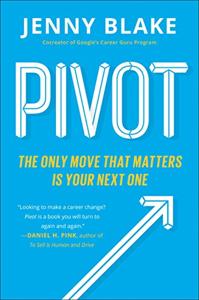
Want to learn the ideas in Pivot better than ever? Read the world’s #1 book summary of Pivot by Jenny Blake here.
Read a brief 1-Page Summary or watch video summaries curated by our expert team. Note: this book guide is not affiliated with or endorsed by the publisher or author, and we always encourage you to purchase and read the full book.
Video Summaries of Pivot
We’ve scoured the Internet for the very best videos on Pivot, from high-quality videos summaries to interviews or commentary by Jenny Blake.
1-Page Summary of Pivot
Overview
If you’re having trouble defining your project’s purpose, think about how it will impact the people around you.
You may be unhappy with your current position or job and would like to start a new company. You may also want to transfer within your firm, change industries, or even manage employees.
Regardless of whether you’re planning to change careers or not, it’s likely that you know that making a major career shift can take time and cost a lot.
However, changing careers doesn’t have to be difficult. There are four steps involved: plant, scan, pilot and launch. A fifth step is also included for managers who want to apply these lessons to their own employees. In this article you’ll learn about how a failed business venture can lead to success in the future; how often Americans change jobs; and what’s so special about cheese at Whole Foods.
Big Idea #1: Changing careers is becoming more common and it’s not something to be afraid of.
Most people are stuck in their jobs and afraid to change. They might have financial concerns, or they could be worried about what friends and family will think. However, it’s perfectly normal for someone to feel that way because the average person changes careers every few years. It used to be that a person would stay with one company his entire life before retiring, but things don’t work like that anymore. Adam Chaloeicheep is an example of this trend; he was once creative director at a real estate development company in Chicago but then left his job and went off to Thailand to study meditation.
Eight months after he left his job, the man was back. He had a clear mind and new passions to guide him. They were fashion, technology, entrepreneurship and brand strategy. The man went back to school so that he could expand his skill set and started his own company called ABC Design Lab. Success came soon after that when he fulfilled financial goals for himself.
Chaloeicheep’s story is a little extreme, but it illustrates the point that many people are unhappy with their jobs and looking for new opportunities.
When you’re in a crisis, it’s hard to think about your career. However, you can use that crisis as an opportunity to make a deliberate career change. It’s called pivoting and it doesn’t require leaving your job. For example, Amy Schonberger felt stuck at her job but she wasn’t ready to leave yet.
Instead of looking for a new job, Schonberger decided to take responsibility for social media and blogging. Her coworkers didn’t want to do it themselves because they thought that would damage their reputations.
But Schonberger knew better, and she soon became the company’s top social media expert. She even got a new job title: director of digital entertainment.
Pivoting is a strategy you use to change your business. It’s not something that happens randomly, however. Let’s look at how the process works in detail now.
Big Idea #2: Before you start, it’s important to define your values. This will help you figure out what you want to achieve.
It doesn’t matter whether you want to start your own company or take on a new role at an existing one, change is difficult. However, you can make things easier by thinking about the big picture and how you want to approach your move. Don’t get caught up in the details of how and when yet; first, establish what’s important to you. For example, my client Justin wanted to leave his family’s real estate business because he was looking for something more meaningful. I didn’t try figuring out exactly what that meant right away; instead we talked about his values—health, financial security, environment and relationships with like-minded people—and from there it was easy to figure out where he could go next.






